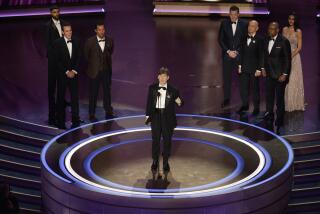Golden Boy to acquire Sears site
Popular Los Angeles boxer Oscar De La Hoya and partners have tentatively agreed to buy the landmark Sears, Roebuck & Co. building in Boyle Heights.
The former champion’s Golden Boy Partners real estate development company and another firm have signed a contract to purchase the mostly empty building at Olympic Boulevard and Soto Street, said current owner Mark Weinstein of MJW Investments.
De La Hoya could not be reached for comment, but development partner Robert Manarino confirmed that a sale was in the works and said, “the site has the potential to be the catalyst for revitalization of an entire community.”
Weinstein declined to disclose the price, but he paid $40 million for the 23-acre property in 2004 and has spent at least $15 million more on plans for a massive residential and retail complex. There was no word on what changes were planned by the buyers.
The Sears complex with a 14-story Art Deco tower was one of the largest buildings completed in Los Angeles in the 1920s and has long been a symbol of the Eastside neighborhood where De La Hoya, 34, grew up.
“People see the Sears tower and know where they are,” said Linda Dishman, executive director of the Los Angeles Conservancy. “It’s not an official landmark, but it is one of the most iconic buildings in Los Angeles.”
The Sears store on the first floor is still in operation, but the sprawling catalog distribution center in the floors above was closed in 1992. The property was later sold as part of a cost-cutting program. Ever since, city officials hoped the site would be reborn as a major economic engine for growth.
But success has remained elusive. Weinstein said he bought the property from an Arizona developer in 2004 after that developer was unable to gain local support for a large shopping and housing project.
Los Angeles City Councilman Jose Huizar said the redevelopment of the Sears site “has long been a dream” for the city.
“The project will bring economic opportunities to an area which greatly needs them,” Huizar said in a statement. “The Eastside of L.A. has traditionally not gotten its fair share of resources and this project will represent an opportunity for everyone in the city to realize and appreciate the valuable resources, rich history, and tremendous economic opportunities this area offers.”
Weinstein said his Santa Monica-based development firm decided to sell the property because it did not fit in with its business plan of focusing on short-term ventures.
“It’s extremely complicated,” said Weinstein of the development. “It would have taken another five to seven years.”
Huizar, in a statement e-mailed from Israel where he was traveling, said he thought De La Hoya would “be a great partner with the city to bring this long-awaited project to fruition. Oscar hails from this part of town, knows the area, understands and respects the needs of the community.”
De La Hoya, who won a gold medal in the 1992 Olympics but lost his WBC super-welterweight title to Floyd Mayweather Jr. in a split decision in May, has said he expects to become a developer as he transitions out of the ring.
In 2005 De La Hoya and his real estate partner announced plans to invest $100 million in housing, stores and entertainment complexes in urban Latino communities, mostly in California. This would be their largest project to date.
His partner in Golden Boy Partners is John Long, who founded Highridge Partners in 1978. The private Los Angeles investment company has acquired, developed or financed more than $6 billion of real estate. Long also is a financial backer of Manarino’s company, Manarino Realty.
Weinstein’s plans for Sears included 480 condominiums, 180 apartments and 750,000 square feet of stores and restaurants laid out on streets that would pass through the property. The hulking Sears building would house stores including Sears on the first floor. The next two floors would include commercial space and possibly a charter school and parking.
The remaining floors would have apartments facing the downtown skyline and more parking. On the roof would be a garden, tennis courts, a swimming pool and other amenities for tenants.
The building was one of nine mail-order fulfillment centers that Sears built between 1910 and the onset of the Great Depression.
Its nearest counterpart, in Seattle, has been converted to a retail, office, warehouse and manufacturing center. The Sears warehouse in Boston also has been transformed into a commercial center.
Sears employees filled mail orders by roller skating around the 200,000-square-foot floors -- about the size of a big-box store such as Costco today -- picking up items and dropping them onto corkscrew slides for distribution by truck or rail.
--
More to Read
Inside the business of entertainment
The Wide Shot brings you news, analysis and insights on everything from streaming wars to production — and what it all means for the future.
You may occasionally receive promotional content from the Los Angeles Times.











